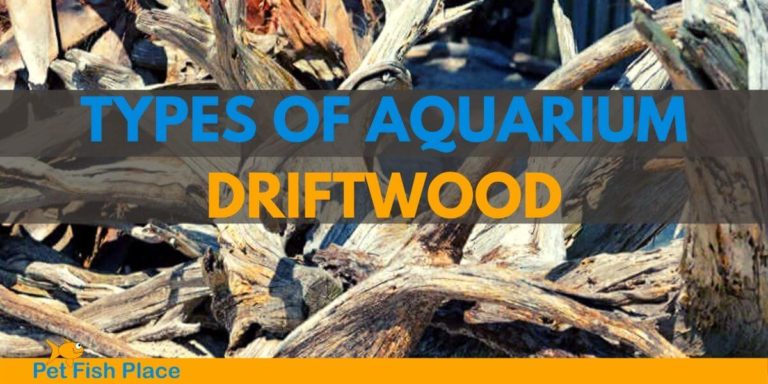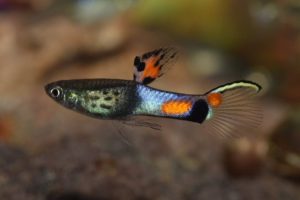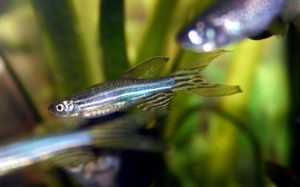Sharing is caring!
![]() The below post may contain affiliate links. Read my disclaimer for more info.
The below post may contain affiliate links. Read my disclaimer for more info.
Any piece of wood that you intend to put in your fish tank should be cleaned properly. Whether it’s a piece of driftwood that you bought at a pet store specifically for aquariums or wood that you found on a nature hike, it must be first prepared. The amount of work required will vary drastically depending on the type of driftwood and whether or not it’s a piece of raw wood found in your yard.
How to prepare store bought driftwood
When you purchase driftwood specifically made for aquarium use, most of the work is done for you. You know that you are getting a piece of driftwood that is completely dried out and the type of wood is already tested to stand-up to an aquatic environment. With that said, you shouldn’t just place it directly into your aquarium without first preparing it.
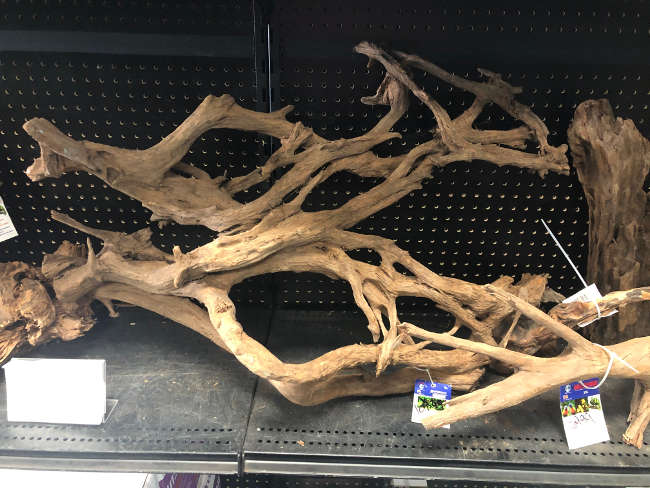
Brush off debris
All store-bought wood will have loose pieces and wood dust on them, not to mention anything else it may have picked up while sitting in storage. Depending on the type of wood you purchase, the amount of debris will vary. You should first brush off the entire piece to remove any loose debris. I find that those fingernail brushes work great for this. You can also use a utility brush, such as this Good Grips All-Purpose Scrub Brush, which is just a larger version of a fingernail brush.
Rinse off wood dust
Once all excess debris is brushed off you can begin to rinse your driftwood. You can hose off the wood dust or run it under a faucet. This step can be skipped if done during your soak phase, which is what I’d recommend.
Pre-soak the driftwood
While soaking your new piece of driftwood you’ll start to notice a couple of things happening. First, you’ll see leftover debris floating on the surface. For those that didn’t rinse during the previous step, you’ll have more of this debris. Simply skim the top of the water to remove it or leave the hose or faucet running, allowing the water to run off.
Secondly, you may notice the water begins to take on a tea color. Not to worry, this is just the wood tannins leaching out of the wood. The type of wood you’re soaking will determine how much tannic acid will be released. In most cases, tannins are perfectly safe for your fish, however, it will affect the clarity of your tank. The more tannins that you remove while soaking, the less that will be released into your aquarium.
Perhaps the most important reason for soaking your driftwood is to get it waterlogged so that it will eventually sink.
The entire soaking phase can take 1-2 weeks for smaller pieces and months, in some cases, for larger pieces. Be sure to weigh down the wood to ensure that it is completely submerged. Also, remember to change out the water every couple of days to remove the tannins.
Boiling your driftwood, if small enough, will speed up this process. For pieces too large to boil you can use hot water, providing that you have an extra bathtub.
How to prepare driftwood found in nature
Providing that you already know that the wood you’ve chosen is safe to use in an aquarium, preparing it is fairly simple. It’s basically the same process for store-bought driftwood but with a few extra steps and precautions.
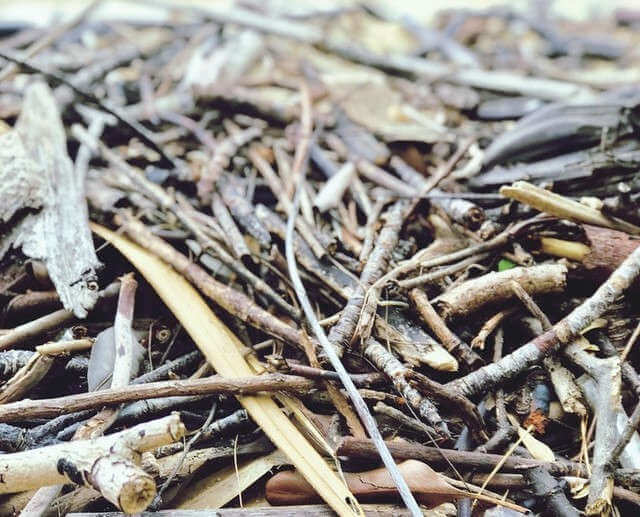
Ensure that the wood does not have rot
Any wood that you find in nature, whether dry branches or wood found floating, must be inspected for rot. If the wood feels soft or spongy, breaks apart easily, or has visible signs of termite damage, it won’t be good for your aquarium.
Remove all the bark
Removing bark can be accomplished by hand in most cases. You may use any flat tool to help get under and pry up any stubborn pieces. I’ve also seen this done pretty effectively with a pressure washer. Be careful done to damage the wood with this method.
Remove excess debris
If the wood is already dry you can remove any excess debris with a utility brush, being sure to get in every nook and cranny. This step can also be done with a pressure washer if careful. If it’s wood that was found floating or is wet from rain, you’ll want to sun dry it completely before attempting this step with a brush.
Soak the driftwood
When it comes to any piece of wood that is found in nature, it has a much higher chance of containing bacteria, parasites, or fungi. This is especially true for pieces that are wet from floating or found in wet conditions such as mud or swamp. For this reason, it is important to either boil the wood, when possible or give it a long bath in hot water.
Aside from that, soaking your driftwood is the same as with store-bought wood. Weigh down the wood so that it remains submerged while also changing the water every so often to remove floating debris and tannins. This soak will take 1-2 weeks, longer for larger pieces, and is considered cured when able to remain submerged without assistance.
Is tap water safe to soak your driftwood
I see over and over again that the water you use to soak your driftwood should be treated. Some fish keepers suggest using RO water, distilled water, or treating the water with an aquarium API Aquarium Water Conditioner. Unless your water is high in heavy metals I have yet to find a solid reason for why any of this is needed. There are plenty of products to test the water hardness such as this API GH & KH TEST KIT
. Any chlorine in your tap water will gas off while soaking long before you introduce the wood to your aquarium.
If you determined that you tap water does need to be treated then do it on your last water change. Before your final soaking period, remove the wood and allow it to dry and then soak it again in treated water. This, of course, will add a ton of time to this process but will also save you a ton of money.
If your water is “good” or you have well water then honestly don’t stress about it.
Benefits of boiling driftwood
There are two main reasons why you would want to boil your driftwood. That is to sterilize the wood and to remove tannins. If the driftwood is small enough, you can place it in a large pot and boil it right on your stove. As mentioned earlier, if the piece is too big to boil in a pot, you can place the driftwood in a large tote or bathtub and run hot water over it. Boiling for 5-10 mins is good for killing off any fungus or parasites. If the goal is to remove tannins faster than would be removed by simply soaking, boil the driftwood for 1-2 hours.
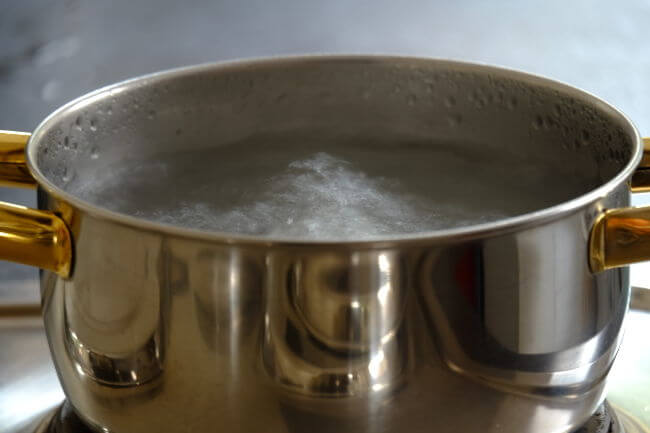
A boil or hot water bath is a good pre-treatment before allowing your driftwood to soak. As for making your wood sink faster, I’m not so sure that boiling will truly have much of an effect. In my experience, boiling did not help with getting the driftwood waterlogged any faster. With that said, this is a common reason that people give so perhaps there is some truth to it that I just haven’t seen yet.
Does driftwood lower pH
The short answer is yes. However, there is more to it than that. The driftwood itself does not lower your pH but instead the tannins that it releases can. The amount of tannin that your driftwood may leach into your water column will depend on the type of wood and the amount of tannins still present after a soak or boil. If maintaining acidic pH is a goal, then tannins are your friend and you should avoid an extended pre-soak of your driftwood. The discoloration that tannins put off is natural and shouldn’t be a cause for concern.
Now not to get too technical, but there are situations where tannins may not affect your pH. Your water being “hard” is one of those situations. There are two measurements of water hardness, GH (General Hardness) and KH (Carbonate Hardness). The one that will prevent tannins from lowering your pH is having high KH. In general, water with high KH will have a higher pH level to begin with. KH kind of works as a buffer for pH swings and “absorbs” acids. The lower KH the more exaggerated PH swings will be when acids are introduced. Alternatively, the higher the KH the less likely that tannins will have any effect.
Tannins in aquariums
Tannins are a term that is commonly used interchangeably with tannic acid. However, while tannic acid is a form of tannin, not all tannins are tannic acids. I hope to dispel that myth. As an example, both Gallic acid, found in tea leaves, and Chlorogenic acid, found in coffee, are tannins. With that said, when we are discussing tannins affecting pH, it is probably tannic acid that is the culprit. Although Humic acid Gallic acid can both lower pH.
With the changes in pH taken into account, tannins are completely safe for your fish. In the wild, it is a natural occurrence and its presence in your aquarium can help simulate a more natural environment for your fish. Providing, of course, your fish is native to such an environment. This is most common with South American species that may prefer a blackwater set-up. This is why there are products out there specifically to darken your water such as driftwood, Indian almond leaves, or liquid humic solutions.
How to make driftwood sink
Time is the only tried and true answer to this question. Although, if you’re in more of a rush like most of us, you can always weigh down the driftwood. A very popular way is to affix the bottom of the driftwood to a piece of slate. This slate can be buried under the substrate to hold the wood in place. This is usually done by drilling a hole through the middle of the slate and screwing it onto the wood.
For smaller pieces, you may just be able to get away with resting heave rocks on the wood. Be cautious with this method one though because I’ve seen a piece of wood come free and throw rocks into the glass walls.
Get creative. Gather a bunch of smaller stones and glue them together with the driftwood or tie off the driftwood to other heavy objects with fishing line or string. Ideally, the best and safest way to ensure that your driftwood will stay submerged is to be patient and allow it to soak however long it needs to.
Aquarium driftwood white fuzz
So, you finally added in that perfect piece of driftwood only to notice that within a few days it is covered in what appears to be, white fuzz. What is this stuff and why did it appear so fast? Not to worry, this is completely normal when it comes to new pieces of driftwood. Whenever you add a new piece of organic material to your tank bacteria will search it out looking for a new home. As driftwood begins to break down bacteria will feed on this new source of carbohydrates and the result is this white fuzzy film.
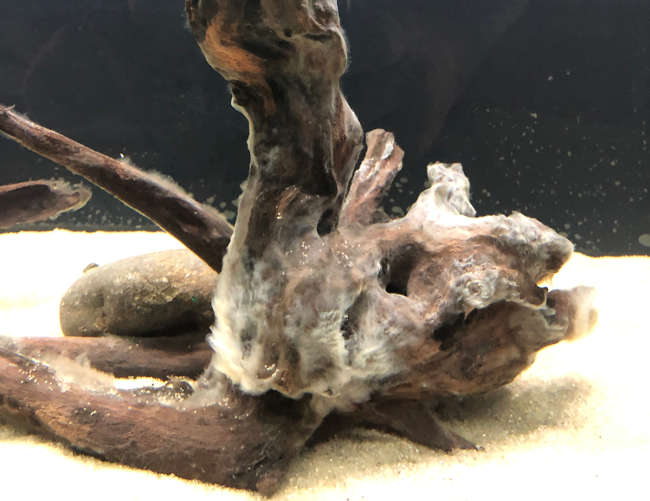
When you notice this white fuzz growing on your driftwood, you’ll have 3 options. One is to add fish that will eat it such as otocinclus, plecos, or even guppies. Snails are also a great addition to your tank and will help consume this fuzz. Another option is to physically remove it or treat it with chemicals by removing the driftwood and scrubbing it down or treating it with products such as Seachem Flourish Excel Organic Carbon Source. The last option is to do nothing. That’s right, this is one of those problems that will eventually resolve itself on its own.
Whatever you decide to do with your white fuzz problem, you won’t do any harm. Yes, it can be pretty unsightly and you may want to remove it manually, just know though that it is completely safe for your fish and shouldn’t be stressed over.
How to clean driftwood conclusion
Now that you are armed with the knowledge needed to prepare a new piece of driftwood for your aquarium you can set out to find that perfect piece. Whether you choose to get your driftwood from a pet store, online, or choose to use a piece of wood found in nature, your fishy friends are sure to appreciate it. There are many different kinds of driftwood available and they all have their different looks and uses so it’s good to have a plan in place.

Sharing is caring!



